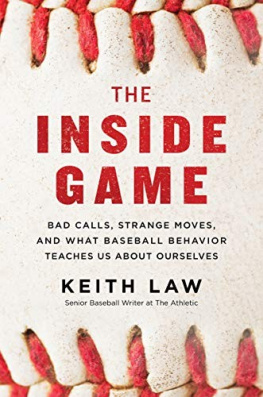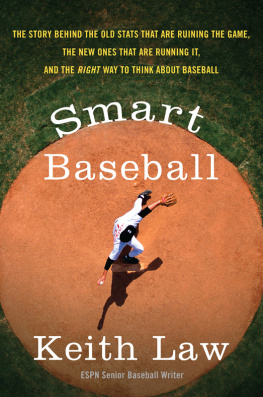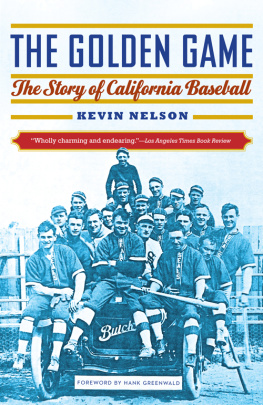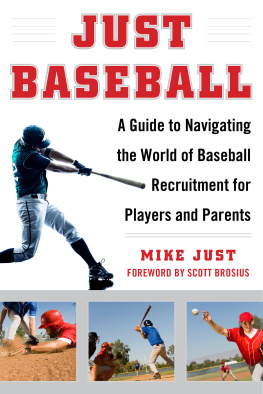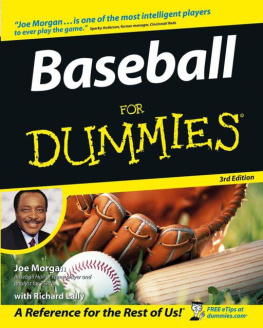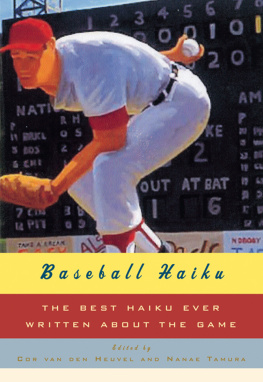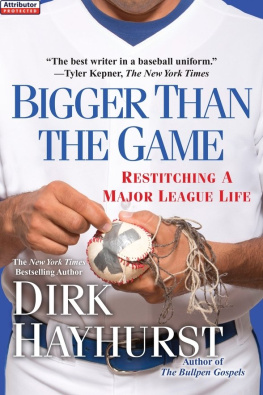To Meredith,
my person
Contents
This is a baseball book. Its also, I hope, not really a baseball book.
When the idea for The Inside Game first came to me, I had a hard time figuring out whether I wanted to use baseball to explain some key ideas about how we think and make decisions, or whether I wanted to use those same ideas, drawn from cognitive psychology and behavioral economics, to explain a bunch of otherwise disconnected events from baseball history. I just liked the idea of putting the two things together and telling a bunch of stories, while also providing readers with enough of the basics of the philosophy to walk away feeling like theyve learned something.
Since the genesis of this book, though, Ive decided to embrace its duality: its a baseball book that uses concepts from economics to make you think more about irrational decisions people have made over the last century in baseball; its also, I hope, a book for the lay audience that explains cognitive biases and illusions, using examples from the baseball world, enough to make you think about them at home or at work, and maybe to decide you want to go read more about the topic.
The idea wasnt some instance of spontaneous generation, of course. As much as Id love to tell you, like a proud toddler, that I do it myself, the reality is that front office personnel around Major League Baseball have been reading about these topics for almost a decade now, spurred by the influx of analysts who have nontraditional academic backgrounds like decision sciences or machine learning. The sabermetric revolution was televised; the revolution in front office thinking was not. Just as some general managers embraced data to try to gain an advantage over other clubs, and then tried to find new advantages in the data before other clubs did, some general managers looked at how they think to try to avoid falling into the kind of cognitive traps that all humans face whenever we make decisions.
My first exposure to this came in the spring of 2014, when, on the recommendation of Sig Mejdal, then the director of decision sciences for the Houston Astros, I read Daniel Kahnemans book Thinking, Fast and Slow. Kahneman won the Nobel Memorial Prize in Economics Sciences in 2002 for having integrated insights from psychological research into economic science, especially concerning human judgment and decision-making under uncertainty. His work with longtime colleague Amos Tversky (who died in 1996) pioneered the field of behavioral economics, showing that much of what economics long believed and taught about humans being strictly rational when making economic decisions was not supported by evidence. Were not that rationalor we are rational subject to the constraints imposed on us by our thinking, which is subject to all kinds of cognitive biases and illusions that Kahneman, Tversky, Richard Thaler (who won the same Nobel in 2017), and others have elucidated over decades of research and numerous publications.
Thinking, Fast and Slow went from unknown to must-read within baseball front offices in a fairly short period of time, a shocking development in a sport that generally moves at the pace of a sloth that is still hungover after a weekend bender. When Jeff Luhnow became General Manager of the Astros before the 2012 season, he and his lieutenant Sig Mejdal, now assistant GM of the Orioles, made it required reading for all new front office hires. The As, Cubs, and Red Sox all followed suit, and by the time I started working on this book in earnest in 2019, every front office source I contacted had either read the book or at least started to do so.
Kahnemans book isnt a sports-ball book at all, although it has a few sports examples because its such a universal interest; its not even an analytics book, although I think in the false dichotomy of the sports world it would be characterized as one. It is a book that asks you to think about thinking so that you will make better, more reasoned decisions. So many choices made in the baseball world are done quickly, using only what Kahneman calls the brains system 1, using intuitive reasoning, including heuristics and shortcuts, which is good if youre in a burning building and need to get out as fast as you can, but less good if youre a major-league general manager trying to decide how many years to give a free-agent reliever. These decisions happen all over baseball, on the field and off, during the season and across the winter. Free agents go to the highest bidder, and draft-eligible players go to the first team to select them, both of which are choices that can easily go astray because of system 1, fast thinking that is prone to errors and biasesif youre the one team that doesnt stop and think about whether your projections are too optimistic or you havent considered all possible scenarios, youre going to make an expensive mistake.
Thinking, Fast and Slow is a wonderful book that changed my thinking, making me hyperaware of these deficits in my own thinking (like, I could stand to talk about this stuff a little less), but its also not for everybody. Its a dense read, and assumes a fair bit of foreknowledge on the part of the reader; if you come in cold, it might be tough sledding. There are other books in the genre that are a bit easier for the lay reader, which Ill cite over the course of this book, and many of them helped inspire passages or even whole chapters here. Ill give a list of such books at the end if youd like to delve further into this area and learn more from the folks whove done the research themselves.
I use a lot of baseball terminology and notation in The Inside Game, although Ive tried to be very consistent in that usage and to stick to the same handful of stats and terms as much as I can. The most common of these include:
- The triple-slash line for a hitter, which looks like .300/.400/.550. Thats batting average, on-base percentage, and slugging percentage. Benchmarks for the three vary from year to year, but the numbers I just used would all be above average in any season. When you hear elsewhere that a player led the league in hitting, they mean batting average. On-base percentage, also called OBP, and slugging percentage, both include batting average as a partial component but include more important information. OBP is a measure of how often a hitter reaches base safely by any meanshits, walks, hit by pitch. Slugging percentage is a crude measure of power, where a single is worth one base, a double two, a triple three, and a home run four, all added up and divided by the hitters at bats.
- WAR, or Wins Above Replacement. This construct adds together values that represent everything a player does on the field to give us a single number that approximates how many extra wins the player was worth to his team in that year. For a hitter, thats his bat, his defense (glove, range, arm), his baserunning, and the value of playing his particular position, since some are harder than others. For a pitcher, thats how good he was at preventing runs, and how much he pitched. There are different ways to calculate these components; the two most popular public calculations come from Baseball-Reference and Fangraphs. I use both in this book. More is better, obviously; a negative number means the players performance actively hurt his team, and they would have been better off grabbing the best free talent available to take that playing time.
- Replacement level. A replacement-level player is worth zero wins under WAR, and represents the hypothetical value youd get from just calling up a random minor leaguer from triple-A at that position, or claiming such a player who had been waived by another team. To put it another way, a replacement-level player is neither helping nor hurting his team with his performance.

